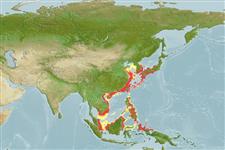Common names from other countries
Environment: milieu / climate zone / depth range / distribution range
Écologie
marin; saumâtre; profondeur 5 - ? m (Ref. 12166). Tropical; 39°N - 1°S, 103°E - 138°E (Ref. 54449)
Indo-Pacific: Indian Ocean (Kuwait Bay and Pondicherry), Java Sea (Singapore), East China Sea (Canton north to the Koreas and southern Japan, as far as Osaka on the Pacific coast and Fukuoka in Sea of Japan, also Peter the Great Bay in Soviet waters).
Taille / Poids / Âge
Maturity: Lm ? range ? - ? cm
Max length : 60.0 cm TL mâle / non sexé; (Ref. 56557); common length : 30.0 cm TL mâle / non sexé; (Ref. 27773); poids max. publié: 140.00 g (Ref. 4883)
Description synthétique
Clés d'identification | Morphologie | Morphométrie
Épines dorsales (Total) : 0; Épines anales: 0; Rayons mous anaux: 43 - 53. Body slender, belly with usually 24 to 25 + 10 to 15, total 34 to 42 scutes. Eye large, lower jaw projecting. Dorsal fin origin at about midpoint of body or a little behind; anal fin origin a little behind dorsal fin base. Swim bladder with a long tube passing back down right side of body above anal fin base.
Found inshore, entering estuaries and presumably able to tolerate lowered salinities; also found in semi-enclosed sea areas (Ref. 11230). A warm-water species that does not reach the northern part of its range in cool years. Used in Chinese medicine (Ref. 12166).
Whitehead, P.J.P., 1985. FAO Species Catalogue. Vol. 7. Clupeoid fishes of the world (suborder Clupeoidei). An annotated and illustrated catalogue of the herrings, sardines, pilchards, sprats, shads, anchovies and wolf-herrings. FAO Fish. Synop. 125(7/1):1-303. Rome: FAO. (Ref. 188)
Statut dans la liste rouge de l'IUCN (Ref. 130435)
CITES (Ref. 128078)
Not Evaluated
Menace pour l'homme
Harmless
Utilisations par l'homme
Pêcheries: hautement commercial
Outils
Articles particuliers
Télécharger en XML
Sources Internet
Estimates based on models
Preferred temperature (Ref.
115969): 17.6 - 29, mean 27.9 (based on 396 cells).
Phylogenetic diversity index (Ref.
82804): PD
50 = 0.5000 [Uniqueness, from 0.5 = low to 2.0 = high].
Bayesian length-weight: a=0.00676 (0.00437 - 0.01045), b=3.02 (2.90 - 3.14), in cm Total Length, based on LWR estimates for this species & Genus-body shape (Ref.
93245).
Niveau trophique (Ref.
69278): 3.8 ±0.61 se; based on food items.
Résilience (Ref.
120179): Milieu, temps minimum de doublement de population : 1,4 à 4,4 années (tm=2; Tmax=6-7; K=0.2-0.4).
Prior r = 0.88, 95% CL = 0.58 - 1.32, Based on 4 data-limited stock assessments.
Fishing Vulnerability (Ref.
59153): Low to moderate vulnerability (34 of 100).
Climate Vulnerability (Ref.
125649): Moderate vulnerability (38 of 100).
